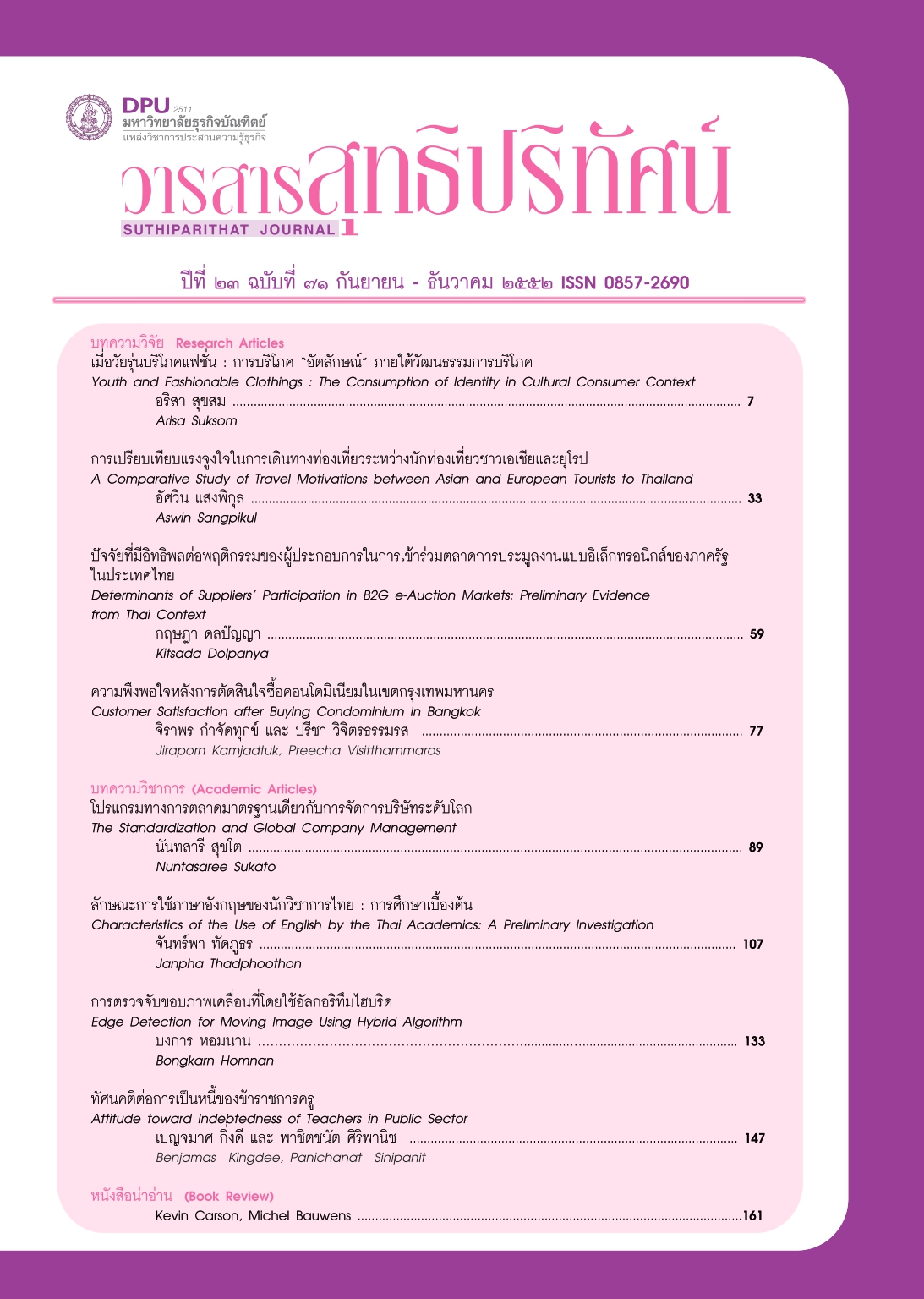ปัจจัยที่มีอิทธิพลต่อพฤติกรรมของผู้ประกอบการในการเข้าร่วมตลาดการประมูลงานแบบอิเล็กทรอนิกส์ของภาครัฐในประเทศไทย
คำสำคัญ:
ผู้ประกอบการสู่ภาครัฐ, ตลาดการประมูลงานอิเล็กทรอนิกส์, การเข้าร่วมงานประมูลของผู้ประกอบการบทคัดย่อ
งานวิจัยฉบับนี้นำเสนอกรอบโครงร่างเพื่ออธิบายความตั้งใจของผู้ประกอบการในการเข้าร่วมการประมูลงานในตลาดการประมูลงานอิเล็กทรอนิกส์ภาครัฐ รวมทั้งระดับของการเข้าร่วมการประมูลงานในตลาดดังกล่าว โดยงานวิจัยครั้งนี้จะทำการศึกษาในตลาดการประมูลงานอิเล็กทรอนิกส์ภาครัฐของประเทศไทย ทั้งนี้การที่มีผู้ประกอบการเข้าร่วมการประมูลน้อยได้เป็นปัญหาหลักที่เกิดขึ้นในตลาดการประมูลงานอิเล็กทรอนิกส์ภาครัฐ ซึ่งจะเป็นผลทำให้ตลาดการประมูลงานอิเล็กทรอนิกส์ภาครัฐขาดสภาพการแข่งขัน อย่างไรก็ตาม งานวิจัยที่เกี่ยวกับการศึกษาพฤติกรรม การเข้าร่วมประมูลงานของผู้ประกอบการในตลาดการประมูลงานอิเล็กทรอนิกส์ภาครัฐยังมีอยู่เป็นจำนวนน้อย โดยเฉพาะอย่างยิ่งที่เกี่ยวข้องกับตลาดการประมูลงานอิเล็กทรอนิกส์ภาครัฐในประเทศกำลังพัฒนา ทั้งนี้กรอบโครงร่างของงานวิจัยนี้ได้พัฒนามาจากกรอบโครงร่างเกี่ยวกับแรงจูงใจและความสามารถ (Motivation-Ability Framework) ทฤษฎีต้นทุนในการดำเนินการแลกเปลี่ยน (Transaction Cost Theory) ทฤษฎีทางสถาบัน (Institutional Theory) และทฤษฎีทรัพยากรเพื่อการแข่งขัน (Resource-Based Theory) จากกรอบโครงร่างนี้ได้นำเสนอปัจจัยหลักที่มี อิทธิพลต่อความตั้งใจของผู้ประกอบการรวมทั้งระดับของการเข้าร่วมประมูลงานใน ตลาดการประมูลงานอิเล็กทรอนิกส์ภาครัฐ ซึ่งประกอบด้วย แรงจูงใจทางประสิทธิภาพ (efficiency motive) แรงจูงใจทางความชอบธรรม (legitimacy motive) สภาพความไม่แน่นอนทางธุรกิจ (environmental uncertainty) และความสามารถในการแข่งขันของผู้ประกอบการ (organisational capabilities) ทั้งนี้ งานวิจัยนี้ยังได้นำเสนอผลเบื้องต้นเพื่อสนับสนุนกรอบโครงร่างงานวิจัยนี้
เอกสารอ้างอิง
Bakos, J. Yannis (1991) “A Strategic Analysis of Electronic Marketplaces.” MIS Quarterly, 15, 3. pp. 295-310.
Bandura, Albert (1986) Social Foundations of Thought and Action Prentice-Hall, New Jersey.
Barney, Jay (1991) “Firm Resources and Sustained Competitive Advantage.” Journal of Management, 17, 1. pp. 99-120.
Beall, Stewart, Carter, Craig, Carter, Phillip L., Germer, Thomas, Hendrick, Thomas, Jap, Sandy, Kaufmann, Lutz, Maciejewski, Debbie, Monczka, Robert and Petersen, Ken (2003) “The Role of Reverse Auctions in Strategic Sourcing.” in Beall, S. (Ed.), CAPS RESEARCH.
Beer, Michael (2003) “Why Total Quality Management Programs Do Not Persist: The Role of Management Quality and Implications for Leading a TQM Transformation.” Decision Sciences, 34, 4. pp. 623-642.
Coase, Ronald H. (1937) “The Nature of the Firm.” Economica, 4, 16. pp. 386-405.
Compeau, Deborah R. and Higgins, Christopher A. (1995) “Computer Self-Efficacy: Development of a Measure and Initial Test.” MIS Quarterly, 1 9, 2. pp. 189-211.
Davis, F. (1989) “Perceived Usefulness, Perceived Ease of Use and User Acceptance of Information Technology.” MIS Quarterly, 13, 3. pp. 319-340.
Day, George S. (1994) “The Capabilities of Market-Driven Organizations.” Journal of Marketing, 58. pp. 37-52.
DiMaggio, Paul J. and Powell, Walter W. (1983) “The Iron Cage Revisited: Institutional Isomorphism and Collective Rationality in Organizational Fields.” American Sociological Review, 48, 2. pp. 147-160.
Duncan, Robert B. (1972) “Characteristics of Organizational Environments and Perceived Environmental Uncertainty.” Administrative Science Quarterly, 1 7, 3. pp. 313-327.
Eisenhardt, Kathleen M. (1988) “Agency- and Institutional-Theory Explanations: The Case of Retail Sales Compensation.” The Academy of Management Journal, 31, 3. pp. 488-511.
Elmaghraby, Wedad (2005) “The Effect of Asymmetric Bidder Size on an Auction’s Performance: Are More Bidders Always Better?” Management Science, 51, 12 . pp. 1763-1776.
Emiliani, M. L. and Stec, D. J. (2005) “Wood Pallet Suppliers’ Reaction to Online Reverse Auctions.” Supply Chain Management: An International Journal, 1 0, 4. pp. 278-288.
Germer, Thomas, Carter, Craig R. and Kaufmann, Lutz (2004) “Purchasing Auction - A Synthesis of Current Research.” Proceedings of The 15th Annual North American Research Symposium on Purchasing and Supply Management, Tempe, AZ, USA, pp. 119-139.
Granados, Nelson F., Gupta, Alok and Kauffman, Robert J. (2006) “The Impact of IT on Market Information and Transparency: A Unified Theoretical Framework.” Journal of the Association for Information Systems, 7, 3. pp. 148-178.
Grewal, Rajdeep, Comer, James M. and Mehta, Raj (2001) “An Investigation into the Antecedents of Organizational Participation in Business-to-Business Electronic Markets.” Journal of Marketing, 65, 3. pp. 17-33.
Gurbaxani, Vijay and Whang, Seungjin (1991) “The Impact of Information Systems on Organizations and Markets.” Communications of the ACM, 34, 1. pp. 59-73.
Hall, Richard (1993) “A Framework Linking Intangible Resources and Capabilities to Sustainable Competitive Advantage.” Strategic Management Journal, 14 , 8. pp. 607-618.
Ivang, Reimer and Sorensen, Olav Jull (2005) “E-Markets in the Battle Zone Between Relationship and Transaction Marketing!” Electronic Markets, 15, 4. pp. 393-404.
Jones, David S. (2007) “Public Procurement in Southeast Asia: Challenge and Reform.” Journal of Public Procurement, 7, 1. pp. 3-33.
Kabadayi, Sertan, Eyuboglu, Nermin and Thomas, Gloria P. (2007) “The Performance Implications of Designing Multiple Channels to Fit with Strategy and Environment.” Journal of Marketing, 71. pp. 195-211.
Lee, Ho Geun and Clark, Theodore H. (1997) “Market Process Reengineering through Electronic Market Systems: Opportunities and Challenges.” Journal of Management Information Systems, 13, 3. pp. 113-136.
MacManus, Susan A. (1991) “Why Businesses are Reluctant to Sell to Governments.” Public Administration Review, 51, 4. pp. 328-344.
Madhavan, Ananth (2000) “Market Microstructure: A Survey.” Journal of Financial Markets, 3. pp. 205-258.
Malone, Thomas W., Yates, Joanne and Benjamin, Robert I. (1987) “Electronic Markets and Electronic Hierarchies.” Communications of the ACM, 30, 6. pp. 484-497.
Merton, Robert K. (1957) Social Theory and Social Structure The Free Press, Glencoe, IL.
Newkirk, Henry E. and Lederer, Albert L. (2006) “The Effectiveness of Strategic Information Systems Planning Under Environmental Uncertainty.” Information & Management, 43. pp. 481-501.
NSO (2007) “A Survey: Perception of Government Procuring Agencies using e-Auction in Thailand.” National Statistics Organization of Thailand.
Rege, Vinod (2001) “Transparency in Government Procurement: Issues of Concern and Interest to developing Countries.” Journal of World Trade, 35, 4 . pp. 489-515.
Smart, Alan and Harrison, Alan (2003) “Online Reverse Auctions and Their Role in Buyer-Supplier Relationships.” Journal of Purchasing & Supply Management, 9. pp. 257-268.
Smeltzer, Larry R. and Carr, Amelia S. (2003) “Electronic reverse auctions: Promises, risks and conditions for success.” Industrial Marketing Management, 32. pp. 481-488.
Son, Jai-Yeol and Benbasat, Izak (2007) “Organizational Buyers’ Adoption and Use of B2B Electronic Marketplaces: Efficiency-and Legitimacy-Oriented Perspectives.” Journal of Management Information Systems, 24 , 1. pp. 55-99.
Teece, David J., Pisano, Gary and Shuen, Amy (1997) “Dynamic Capabilities and Strategic Management.” Strategic Management Journal, 18, 7. pp. 509-533.
Teo, H. H., Wei, K. K. and Benbasat, I. (2003) “Predicting Intention to Adopt Interorganizational Linkages: An Institutional Perspective.” MIS Quarterly, 27, 1 . pp. 19-49.
Wade, Michael and Hulland, John (2004) “Review: The Resource-Based View and Information Systems Research: Review, Extension, and Suggestions for Future Research.” MIS Quarterly, 28, 1. pp. 107-142.
Williamson, Oliver E. (1981) “The Economics of Organization: The Transaction Cost Approach.” The American Journal of Sociology, 87, 3. pp. 548-577.
Williamson, Oliver E. (1999) “Strategy Research: Governance and Competence Perspectives.” Strategic Management Journal, 20, 12 . pp. 1087-1108.
ดาวน์โหลด
เผยแพร่แล้ว
รูปแบบการอ้างอิง
ฉบับ
ประเภทบทความ
สัญญาอนุญาต
เนื้อหาและข้อมูลในบทความที่ลงตีพิมพ์ในวารสารสุทธิปริทัศน์ ถือเป็นข้อคิดเห็นและความรับผิดชอบของผู้เขียนบทความโดยตรงซึ่งกองบรรณาธิการวารสาร ไม่จำเป็นต้องเห็นด้วย หรือร่วมรับผิดชอบใด ๆ
บทความ ข้อมูล เนื้อหา รูปภาพ ฯลฯ ที่ได้รับการตีพิมพ์ในวารสารสุทธิปริทัศน์ ถือเป็นลิขสิทธิ์ของวารสารสุทธิปริทัศน์หากบุคคลหรือหน่วยงานใดต้องการนำทั้งหมดหรือส่วนหนึ่งส่วนใดไปเผยแพร่ต่อหรือเพื่อกระทำการใด ๆ จะต้องได้รับอนุญาตเป็นลายลักษณ์อักษรจากวารสารสุทธิปริทัศน์ก่อนเท่านั้น







